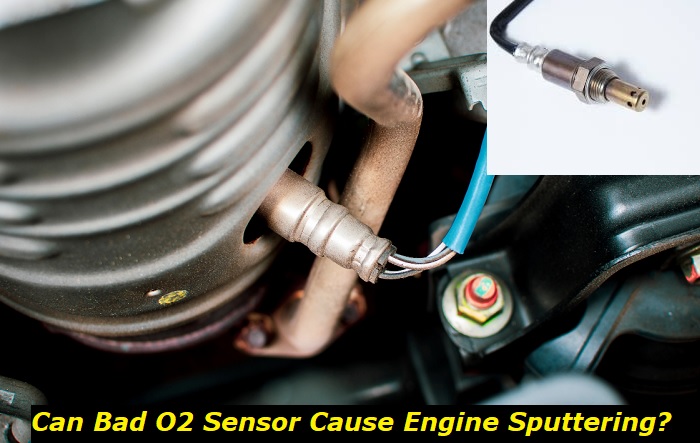A bad O2 sensor can cause sputtering in a car. This can also happen if the sensor wasn't installed correctly. There are other possible reasons why a vehicle would sputter. I'll mention them in this article along with the other symptoms of a bad O2 sensor. Fixes will be described as well, of course.
Emission system electrical problems highlights
- Level of urgency:medium
- DIY inspection:possible but complicated
- DIY repairs:impossible
- Can you drive?yes
- Price of repairs:$200 - $800
- If ignored:car stalling, getting stranded, various errors
- Ways to fix:OBD2 scanner check, sensor replacement

Other Reasons for Engine Sputtering
Sputtering happens when the ECU (engine control unit) lets in excess air into the combustion chamber. It can also be a sign that the engine isn't attaining complete combustion.
Your car may feel like it's struggling to stay running because of unsteady power or backfiring. The movement can be sudden and unstable, with an abnormal change in engine sound. See the other reasons an engine sputters below.
- Poor fuel quality or low fuel level
- Irregular engine timing
- Malfunctioning ECU
- Faulty ignition system or exhaust system
- Defective fuel pump or fuel injector
- Clogged/damaged fuel or air filter
- Blocked catalytic converter
- Worn or failing wires/spark plugs
- A damaged/leaking seal, gasket, or vacuum hose
- Bad/dirty MAF (Mass Airflow) sensor or TPS (Throttle Position Sensor)
- Bad/dirty EGR (Exhaust Gas Recirculation) valve
Other Symptoms of a Bad O2 Sensor
There are many more oxygen sensor problems that you need to worry about, apart from sputtering. That's how important the sensor is. And a faulty one needs attention ASAP. See the other possible signs of a bad O2 sensor to watch out for.
1) Check Engine Light (CEL) Coming On
Your car's CEL will illuminate when the O2 sensor transmits an error code as a sign of a fault. The code will be received by the ECU which will in turn trigger the CEL to activate. Remember that your dashboard's check engine light can come on due to other issues, so you need to be sure that it's the sensor.
2) Surging of the Engine
Surging is another engine performance issue like sputtering. It can be referred to as the opposite of sputtering because it deals with the reverse side of the oxygen-fuel ratio problem. This time, the situation involves excess fuel in the combustion chamber.
3) Catalytic Converter (Cat) Damage
The O2 sensor can cause indirect damage to a catalytic converter. It occurs when the sensor works abnormally and transmits a wrong message to your car's main computer chip. The chip in turn utilizes the message to unnecessarily increase the fuel level in the combustion chamber.
Your cat will get blocked, overheat, and sustain damage due to the added hydrocarbons. You'll start smelling a rotten egg odor around your car because of the presence of excess unburnt fuel in the cat.
4) Bad Fuel Economy
Loss of fuel efficiency is to be expected because your engine isn't working as it should. It may be overworking or using excess fuel which the vehicle doesn't need. Gasoline will keep burning faster and you'll be unable to achieve the normal mileage per gallon.
5) Too Much Exhaust Smoke
More fuel in the combustion chamber means more smoke coming out of the exhaust. So excess fuel in the chamber plus a defective catalytic converter will lead to the production of black smoke.
6) Increased Emission Levels
Too much hydrocarbons in the engine means that there'll be more emissions. It might put you at risk of failing an emissions test because of the error codes being generated.
7) Weird Knocking, Rattling, or Pinging Sounds
Such noises could be heard from beneath the engine because of carbon buildup in the combustion chamber.
8) Other Engine Performance Issues
- Engine misfires
- Stalling
- Rough idle
- Poor acceleration
- Engine power loss
- Disruption of engine timing, combustion intervals, and air-fuel ratio
How To Change a Failing or Bad Oxygen Sensor
A bad O2 sensor can only be fixed by replacing it with a new one. But many other common faulty electrical or mechanical parts can result in an irregular air-fuel ratio. So hire an expert for proper diagnoses and repairs. It may not be enough to just swap out the sensor alone.
You may be lucky to discover that what the sensors need is to be taken out, carefully cleaned, and re-installed. And when you use your car again, the sensors may start working perfectly again. O2 sensors don't require regular servicing like some other parts of your car, but you can check them once in a while.
You can swap out the sensor after a mileage of 30,000-100,000 or whenever it fails-depending on your vehicle model. Purchasing a new sensor costs $50-$300, while the bill for professional labor is $50-$150 per hour. The wideness in price range is partially based on the vehicle's make and model. See the steps for an O2 sensor replacement below.
Step 1: Scan for Error Codes
Use an OBD2 scan tool to confirm that the issue is an O2 sensor. The O2 sensor-related codes that may pop up are P0030, P0031, P0130, P0131, P0132, P0133, P0134, P0137, P0140, P0141, P0161, P0172, P2195, and P2270.
Step 2: Wait for the Engine To Cool
Do this for at least 30 minutes as a safety precaution before beginning the swap. You can wear protective gloves before touching the target area.
Step 3: Jack Your Car Up
Park the vehicle on a flat surface and jack it up to enable you to get to the sensors underneath.
Step 4: Locate the Faulty Sensor
It typically resembles a spark plug with a wire attached to it. The first sensor is usually located near the motor in the engine section. You'll see it on the exhaust pipe that passes from the motor to the rear of your car.
The second sensor should be at the back of the catalytic converter-just behind the front wheels. Catalytic converters are metallic and they're found on the exhaust line. They resemble mufflers and they can be cylindrical or oblong.
Most recent-year model cars have four O2 sensors. There'll be two near the motor in the engine section and two near the cat. It may be hard to get the locations of the sensors because their positioning varies based on car make and model. Even your mechanic may not find it easily.
Step 5: Detach the Sensor's Electrical Connection
Trace the wire that starts at the bottom of the sensor to where it ends in a plug fixed into an outlet. Disconnect it by pushing the small tab on the plug's end with one hand and pulling the plug with the other.
Step 6: Loosen the Sensor
Spray some penetrating oil onto the opening where the sensor links with the exhaust line. This will make it easy to unscrew the sensor. Wait for at least 10 minutes for the lubricant to take effect.
Step 7: Unscrew the Sensor
Utilize a compatible ratchet wrench for this part. A 3/8-inch (0.95-centimeter) ratchet wrench will work for a 7/8-inch (2.2-centimeter) sensor socket. Opt for an open-end wrench if you don't have that type. Fit the wrench around the sensor where it links to the exhaust line and turn it anticlockwise to unscrew it.
Step 8: Apply Anti-Seize on the New Sensor
The new sensor should be the same as the former one, that is, compatible with your car. Aftermarket O2 sensors usually come with anti-seize gel. You can use it to lubricate the sensors' threads (grooves in the metal ring near a sensor's tip). Wear protective gloves to protect your hands from smears.
Step 9: Install the New Sensor
Put the sensor into where you removed the old one from. It should be well-centered before you begin to turn it clockwise. Use a wrench or the sensor's socket to secure it tightly (but moderately) in place.
Step 10: Re-attach the Sensor's Electrical Connection
New sensors typically come with their own wires, so you can just put the wire's plug into the outlet port near the exhaust line. Simply push the plug in until it's secure. Ensure that no part of the wire is in contact with the areas of the vehicle that heat up when the engine is running.
Other Related Fixes You Can Try
1) Solution To Rough Idling and Stalling
A temporary fix that may work for this problem is to turn off the engine and restart it. You may have to give it two or more tries before it can work. But ensure that you take your car for a maintenance check ASAP.
2) Solution to Catalytic Converter Damage
Get a professional to change both the cat and O2 sensors if the former wasn't spared after the failure of the latter. It may cost you $500-$2,000 or higher to replace a cat (labor bill included).
3) Solution To Too Much Exhaust Smoke (Smell of Gasoline or Sulfur)
An urgent thorough maintenance check should be conducted and ALL the O2 sensors must be swapped out!
Can You Drive with a Malfunctioning O2 Sensor?
You can drive with a faulty oxygen sensor or without one. But it's not worth the great risks to your catalytic converter and engine as a whole. Drive quickly to an auto repair shop once you notice that the sensor is misbehaving. I'll rather say that you should NEVER drive with a bad sensor.
Conclusion
The most important thing to note in this article is the urgency of fixing a faulty O2 sensor. Your engine's O2 content may be influenced by certain environmental factors; such as air pressure, temperature, and altitude. Engine factors include load and temperature during combustion.
About the authors
The CarAraC research team is composed of seasoned auto mechanics and automotive industry professionals, including individuals with advanced degrees and certifications in their field. Our team members boast prestigious credentials, reflecting their extensive knowledge and skills. These qualifications include: IMI: Institute of the Motor Industry, ASE-Certified Master Automobile Technicians; Coventry University, Graduate of MA in Automotive Journalism; Politecnico di Torino, Italy, MS Automotive Engineering; Ss. Cyril and Methodius University in Skopje, Mechanical University in Skopje; TOC Automotive College; DHA Suffa University, Department of Mechanical Engineering






Add comment